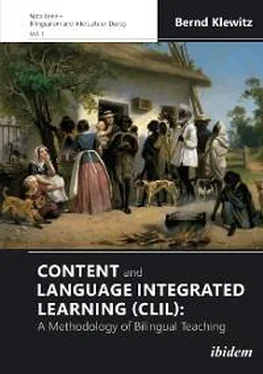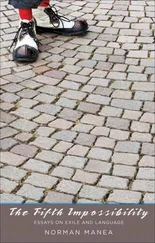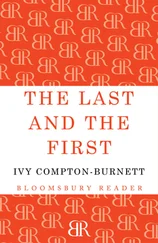The example raises questions like these: Does bilingualism really work at an early age? How does it develop in the long run? Can it eventually result in a balanced command of two languages? If we take these questions further and to the level of language acquisition and learning in a school context, we would have to scrutinize bilingual programs like immersion and its European counterpart CLIL (Content and Language Integrated Learning). With regards to terminology, “ bilingual ” might appear as a misnomer or, at least, ambiguous, because it can either refer to the (pedagogical) aim to enhance a native-like command of two languages or the strategy of using two languages in the process of instruction. In any case, it makes sense to disentangle or even dismantle some myths and legends of bilingualism.
1.1 Dismantling Myths and Legends of Bilingualism
Following a wider definition of the term bilingualism as “the use of more than one language in daily life” (Meisel 2019: 2), it is far more common than practicing one language only, so we can safely say that “the majority of the world’s population is bilingual” (ibid.: 3). But apart from a certain ambiguity the term bilingualism 1refers to a variety of contexts and diverse situations where the exposure to more than one language is inevitable—including labor migration as well as minority languages in multi-ethnic societies, but also deliberate parent-decisions to foster language learning. As a result, simultaneous or successive bilingualism will eventuate, depending on existing motivation and societal conditions or pressures. In predominantly monolingual environments parents might consider bilingualism as an advantage for their children and encourage the use of more than one language in their families.
The latter is the case in the aforementioned family from Southern Germany where according to the parents “ to go bilingual ” was a process-driven decision due to their previous stays abroad in Anglophone countries for a longer period of time. Peter, in particular, refers to his experience that addressing his children in English allows him to communicate with them in a more reflective manner. In other words, in situations where he would normally have reacted more emotionally or even sternly he would take a moment to consider what to say as a kind of inner translation, sometimes even looking for the right expression. Reflecting first what he was going to say would create some space for consideration, if only just for a couple of seconds. As he was, in part, brought up in English speaking countries and attended schools there, he also developed a very emotional relationship with the English language. He thought this might help him to better express his feelings and convey emotions in a more authentic manner to his children.
What started as an experiment four years ago developed into a way to create a special relationship within his family, hoping that his love of another language would take root in his children and allowing for intimate communication without excluding other family members. Also, and not the least part of his motivation, was the chance to pass on a perspective of daily life and routines that would open another door to the world. Ava and Paul, hopefully developing simultaneous bilingualism, could be given better opportunities to travel the world and work in different countries later on. And last but not least, Peter enjoys this language experience thus creating an intrinsic motivation to continue speaking English to his children.
In reflecting this ongoing process from his children’s point of view, the feedback he gets from his older daughter Ava is overall positive in that she can safely differentiate between the two languages, accept that there is one person, one language (later on to be referred as the OPOL principle, see 1.6) and that her comprehension of two languages is getting on very well. She enjoys, for instance, listening to English children’s books read to her and nursery rhymes and already knows a number of English songs by heart. Opening windows into another culture are thought by both parents to be a tremendous advantage.
1.2 The Guide for Bilingual Parents
The conviction that bilingualism is right for his family and even intensifies their relations in a special way is shared by longstanding scientific research on bilingualism in early childhood presented in a most recent Guide for Bilingual Parentsby Professor Jürgen M. Meisel. The former Chair of the Research Center on Bilingualism at the University of Hamburg has been counselling parents for more than 35 years in both Germany and Canada (University of Calgary), and expertly confronts the advantages and—in his own words—“ mostly mythical drawbacks of raising children with a command of two or more languages ” (Meisel 2019: cover). A closer look at risks and benefits will become useful for an integrative bilingual methodology which aims at successive bilingualism in the long run.
Discussing so-called risksof early childhood bilingualism, Meisel’s parental guide draws upon the following “rumors” first, namely
whether two languages can be kept apart,
how to avoid a “macaronic language mix” (Meisel: 8; 58),
that balanced bilingualism is not possible and puts excessive strain on mental capacity,
that fusion of two languages affects cognitive development and would lead to semi-linguals with children torn between two languages and cultures, thus unable to develop their own personalities (cf. ibid.: 7 ff).
There seems to be sufficient evidence, however, that children can distinguish between different languages at an early stage already and Ava’s reaction to her grandfather is a case in point (see case vignette above). Various, even opposing theories of Second Language Acquisition (SLA) support the view that the mental grammars of bilinguals develop independently, whether one follows a generative SLA with Chomsky’s Universal Grammar(UG), the so-called Human Language Making Capacity(LMC; supported by Meisel: 35), its radical version of the Fundamental Difference Hypothesis (FDH, Bley-Vroman 2010) or more recent approaches in cognitive theory, constructivism and the findings of neuro-science. The alleged “ macaronic language mix” turns out as code-switching and the sign of a conscious choice as “ the ability to select languages according to interlocutor, situational context, topic of conversation etc .” (Meisel: 72). All these paradigms do not only refer to childhood simultaneous bilingualism but also pertain high relevance for successive bilingualism in CLIL programs and are therefore discussed in the following juxtaposition between a nativist and a cognitive position (see chapter 2). Code-switching itself becomes part of CLIL-tools and as “ translanguaging” works together with other linguistic skills such as mediation, visual representations and digital implements in the context of interactive methods, instructional strategies and scenario techniques (see 8.2-8.5).
On the bilingual credit sideare the following aspects:
accelerated language acquisition is one of the undisputed benefits of bilingual development,
native-speaker competence seems possible, provided a sufficient input is available,
reading skills and favorable intelligence tests are counted as further added value, based on neurological advantages,
bilingual children become part of another social world,
they are able to express the same ideas in two languages,
they are immersed in cultures negotiating different meanings and values.
Meisel’s guidebook for “ bilingual parents ” is listing these and further benefits to encourage these processes and advising adults to persevere in their attempts to create rich, multi-lingual situations (cf. Meisel: 7 ff, 221 ff).
Читать дальше












